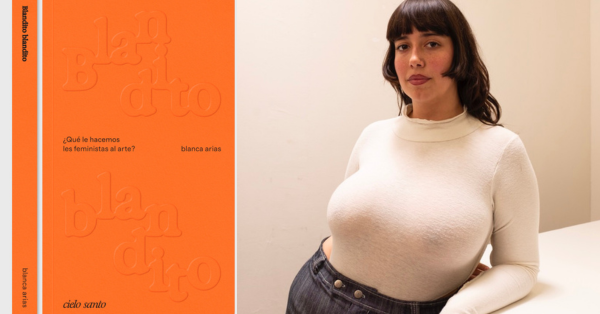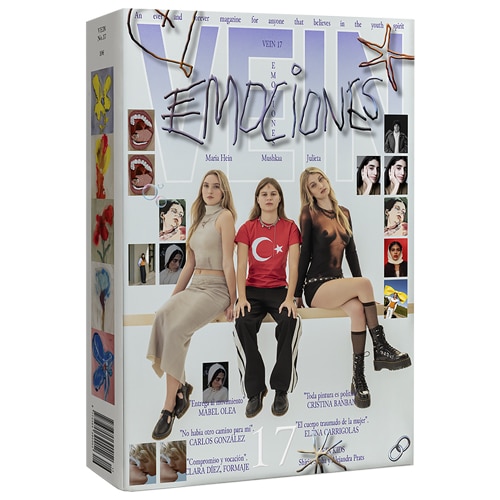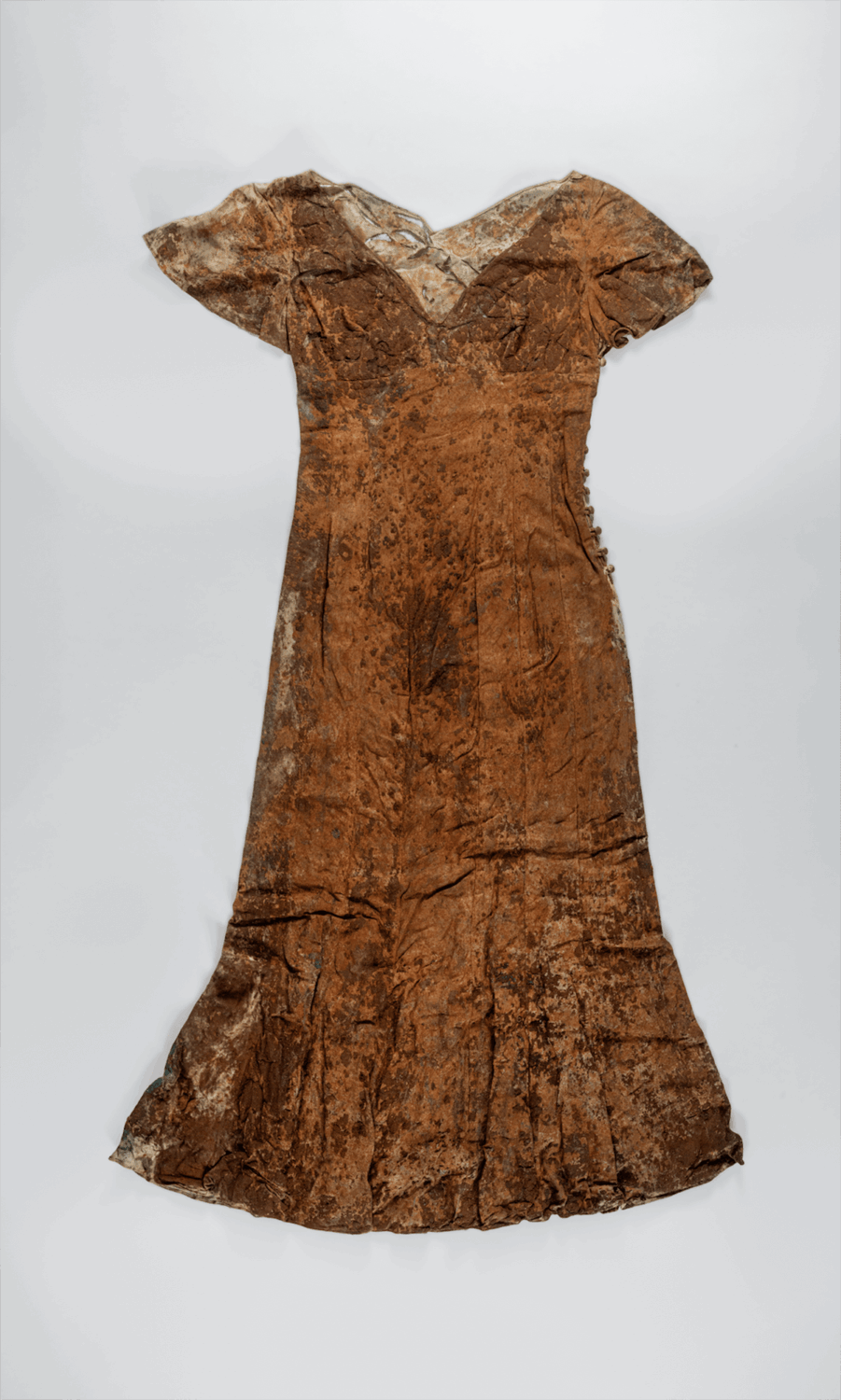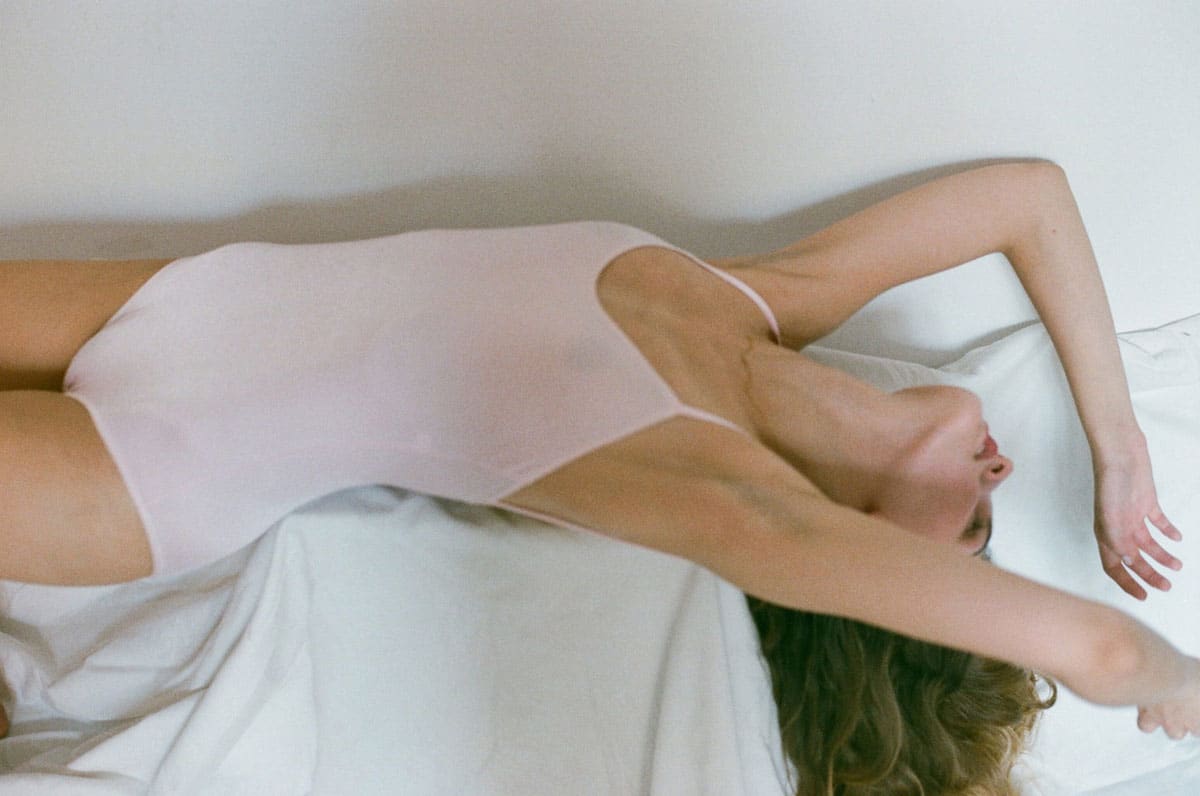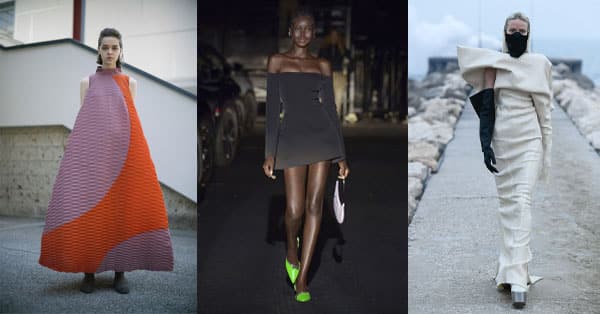Dirty Looks: Desire and Decay in Fashion, presented at the Barbican, brings together designers such as Hussein Chalayan, Maison Margiela, Alexander McQueen and Vivienne Westwood to explore how dirt and decay reshape fashion’s aesthetics. At #VEINDIGITAL we speak with curator Karen Van Godtsenhoven.
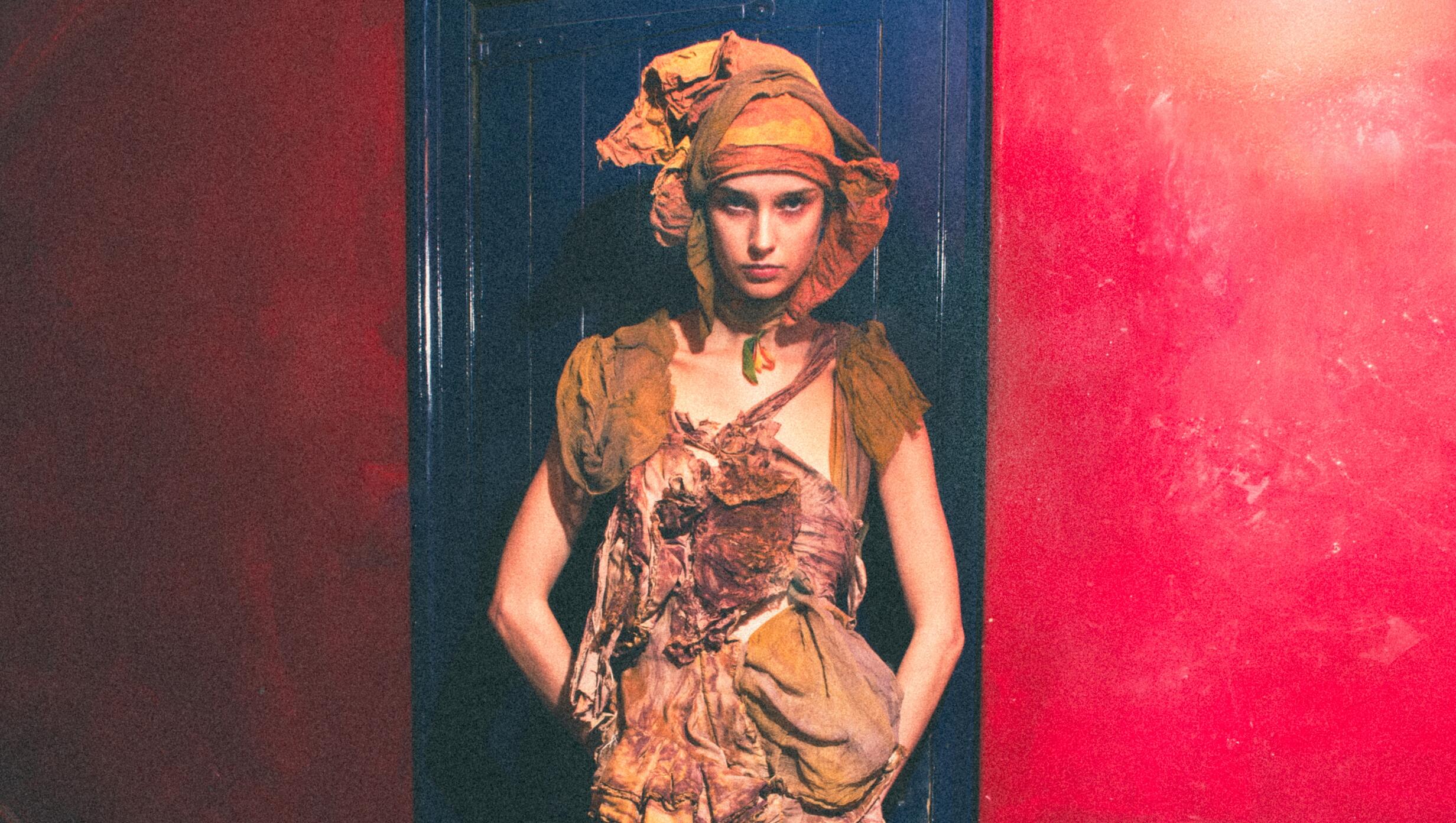
Paolo Carzana Fall/Winter 2025
Fashion is viewed as matter and as a situated creative practice at the Barbican Centre, London, where the fall exhibition Dirty Looks: Desire and Decay in Fashion runs until 25 January. Including around 120 works from 60 different designers, the show explores the vast idea of dirt in relation to fashion from multiple perspectives. We talked with curator Karen Van Godtsenhoven about the concepts behind the exhibition: “Dirt still evokes difficult feelings. We consider dirt from nature or from mud and things like soil, but there is also dirt from the body, so it’s more sexual, like bodily fluids. And also dirty looks as in how we look at something or someone is also about sexuality. And there is a bigger idea, dirt from fashion, the waste from fashion, that is the actual dirt.”
Based on anthropologist Mary Douglas’s concept from 1966, dirt as matter out of place, the show begins, as the curator explains, “introducing this idea of Western fashion, of cleanliness and beauty versus dirtiness and decay and how dirt has actually evolved from something that was more subcultural or transgressive, from the punk era, to something that is now very mainstream: to have a torn or decaying look. Today is more about luxury, desirability, and about the transformation of materials and handcraft, things that are not made to look standardized, that are made to look dirty, but have also become a highlight of couture.”

Robert Wun Fall/Winter 2024
The exhibition has two floors: “It’s like the conscious and the subconscious,” says Van Godtsenhoven. “Upstairs is like fashion history and downstairs it’s how it is being digested today, in contemporary practices. And the last rooms, it’s this philosophical reflection on the industry, sustainability and the reuse of fast fashion waste or materials, as well as the decolonial perspective of non-Western countries.”
Upstairs, the first room is dedicated to Hussein Chalayan’s pieces, from his graduate collection from 1993 to Medea in 2002, and his concept of ‘future archaeology’. “I feel that he is such an important voice that connects to today,” explains the curator. The Turkish Cypriot designer experimented with burying and exhuming clothes, often with metal filings, where garments carry traces of an event. His unburied garments are here hanging over a platform of soil.
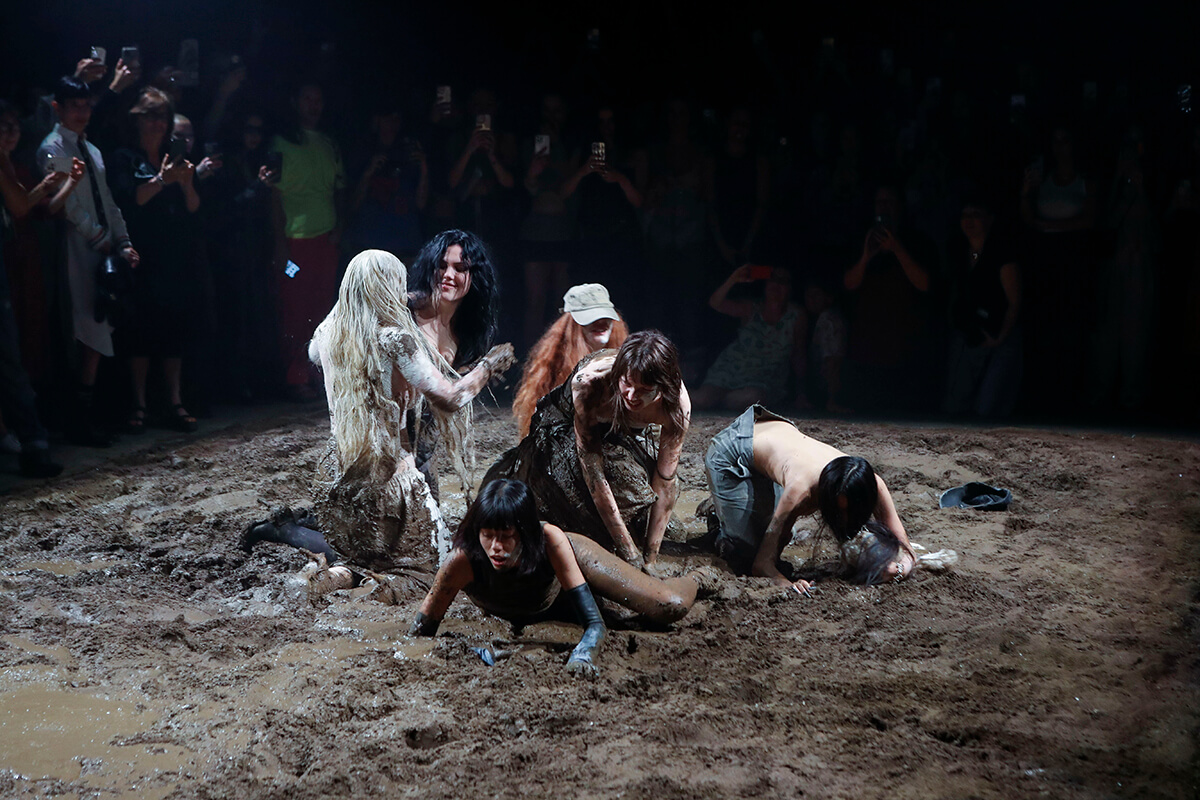
Elena Velez Spring/Summer 2024
The next room, Nostalgia of Mud, begins with the homonymous Westwood-McLaren collection from 1983 exemplifying how dirt became a symbol of authenticity and connection with the natural world, a sensibility that would influence avant-garde fashion throughout the 1990s and 2000s. Today, this romanticisation of the “natural” is read critically, yet the attraction to mud, folkloric motifs and decay persists as a form of rebellion against mass production. The room includes pieces by Spanish designer Miguel Adrover, a designer that currently calls out on the dirt of the fashion system. The curator recalls: “I visited him a few times in Mallorca in his family’s 700-year-old house. He built a small building in his backyard with all his clothes. It was all still intact. So we just went through it. And he came to London. He almost never travels, so it was very special that he came.”

Hussein Chalayan Spring/Summer 1995
We then go into Romantic Ruins, where through elaborate effects, we see the dresses’ artificial ruination. Among dressed manequins, an Alexander McQueen dress from the 1995 collection, Highland Rape, lies on its own inside a see-through vitrine. It is a floral lace dress torn and encrusted with mud, materialising the gendered politics of dirt.
Moving forward we enter Spectres of Dirt. Many Galliano’s Maison Margiela artisanal collections pieces are here, but also some ready-to-wear pieces like a pair of trompe l’oeil jeans from Acne Studios and the Balenciaga destroyed trainers from 2022, hanging with their laces knotted from a pipe, like sneakers you find hanging from cables in a marginalised neighbourhood.

Comme des Garçons Fall/Winter 2005
Stains as ornament are explored, (in a room staged like a butchery/laundry room) with various ensembles including Moschino, Helmut Lang and Rick Owens. Then, Leaky Bodies takes bodily fluids as the conductive line. Wet looks here, like Di Petsa’s, take centre stage, next to excerpts from Dirty Girls (1996), a documentary short exploring the life of grunge high school students who defended being dirty as a way of life.
Glittering Debris focuses on garments made from pre-existing materials, turning trash into treasure, including a Paco Rabanne Haute Couture look made with plastic bottles, a plastic bag T-shirt from Martin Margiela, and a pigeon clutch from JW Anderson. The final room upstairs highlights Chinese designer Ma Ke, who works on the relationship with the earth and the loss of craft and tradition.
About the curation downstairs, Van Godtsenhoven notes: “We have commissioned work from young designers and artists who work with similar ideas, it’s a search to answer the question: is there still room to create? There is so much fashion and fast fashion going around, and these designers are all thinking about these issues, it’s a part of their work. Now it’s more about repair and trying to find a solution out of the current system.”
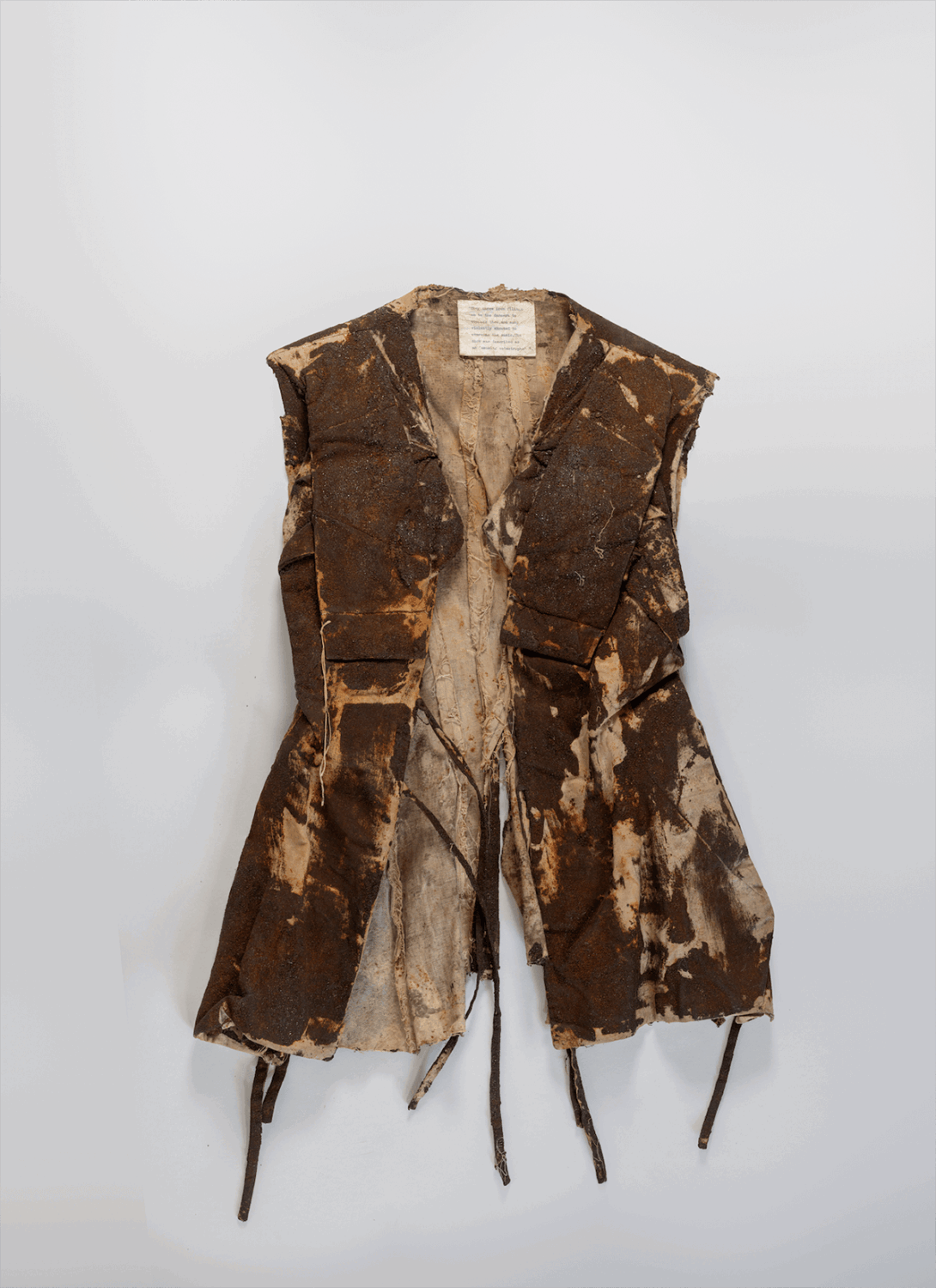
Hussein Chalayan Fall/Winter 1993
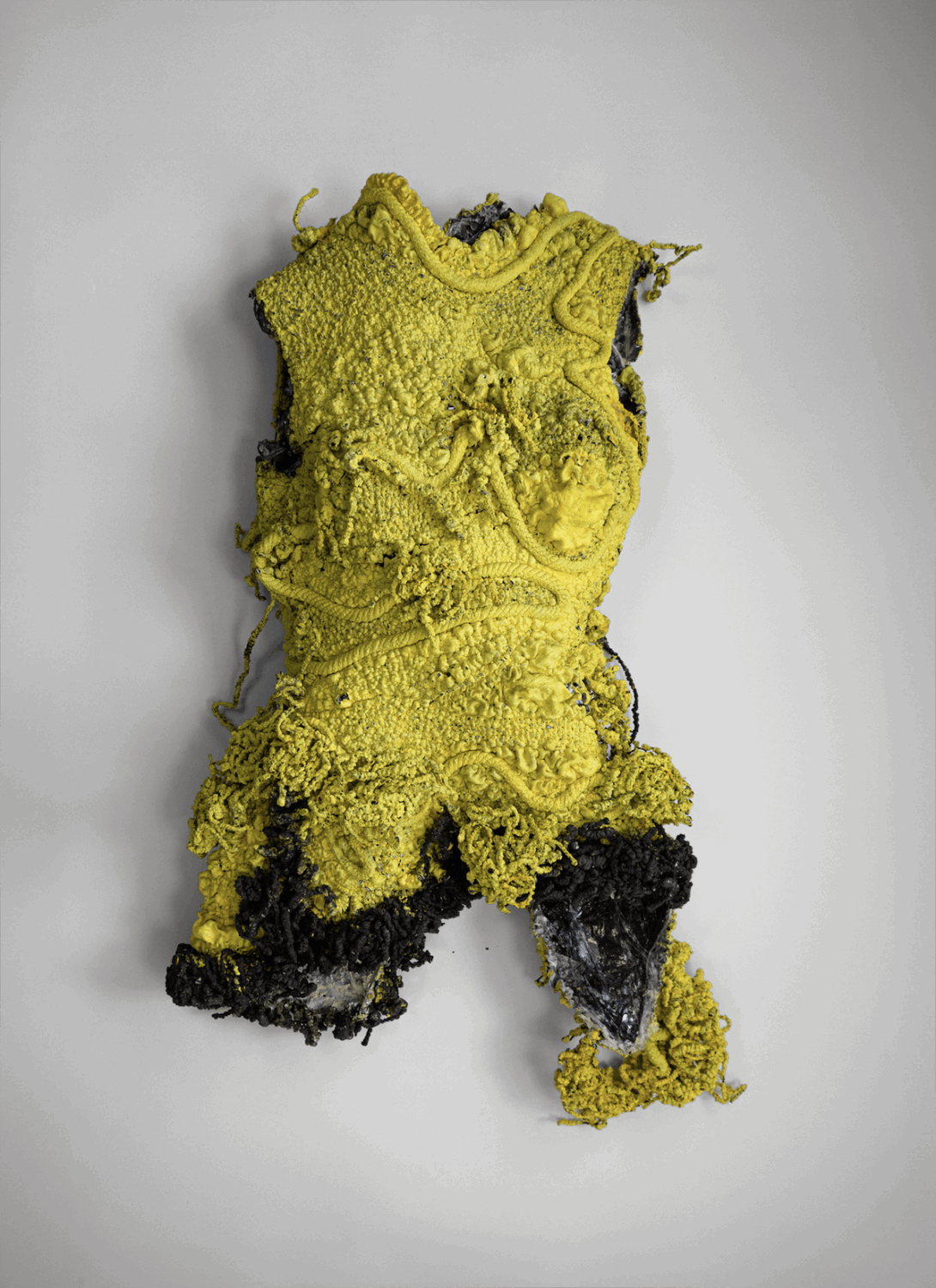
Piero D’Angelo 2019
Hussein Chalayan Fall/Winter 1994
Here, we find subversions of the sanitised versions of feminism that are often portrayed by fashion. Elena Velez showcases two white pristine garments that gradually become overwhelmed by dirt in a film described by her as “a chronology of deterioration.” Artist Michaela Stark talks about what are read as imperfections in the female body, showcasing framed distressed period-inspired undergarments, and close-up pictures of the artist’s body wearing them. In the middle of the space, we can observe After the Orgy, a sweaty installation by Solitude Studios, where bog bodies, in the image of the modern world’s weightlessness, remain only as the clothes they wear, a shell of themselves. Three final rooms reflect on excess, material transformation, and the blurring of natural and artificial boundaries.
About the spatial design, by Studio Dennis Vanderbroeck, the curator explains: “There is this tension between the sterility and the cleanliness of the morgue, butcher or the dry cleaner with the rail going through it, and then the gradual decay. It starts from a white cube and then you start to see more and more cracks. This tension makes the fashion interesting. SVD is great because they work in theatre and fashion, and… the body, you need to know how to display bodies. You have to try to make it performative. It’s also interactive with the visitor, because it’s ‘dirty looks’, it’s also about how you are looking at things, as part of the mise-en-scène.”
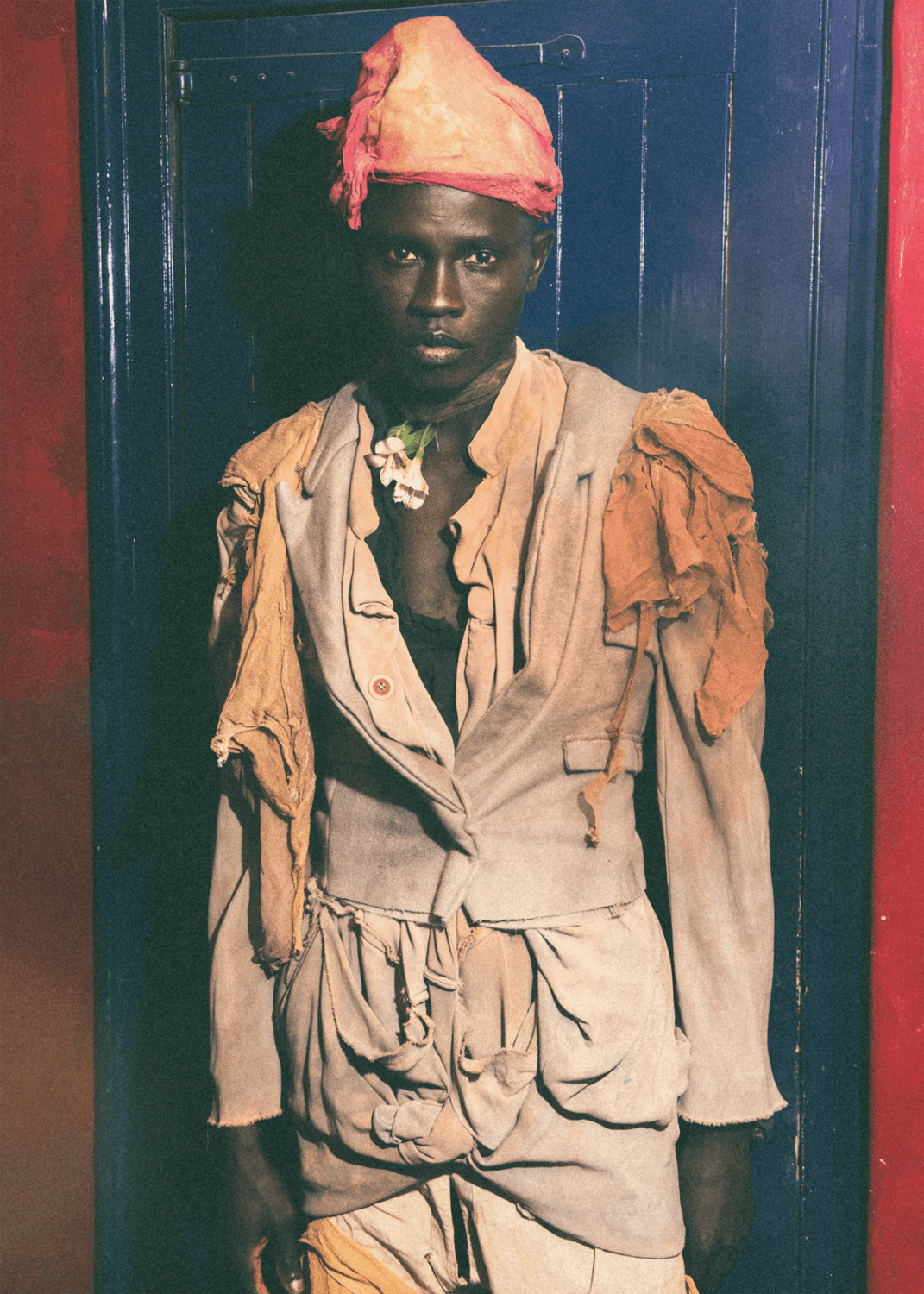
Paolo Carzana Fall/Winter 2025
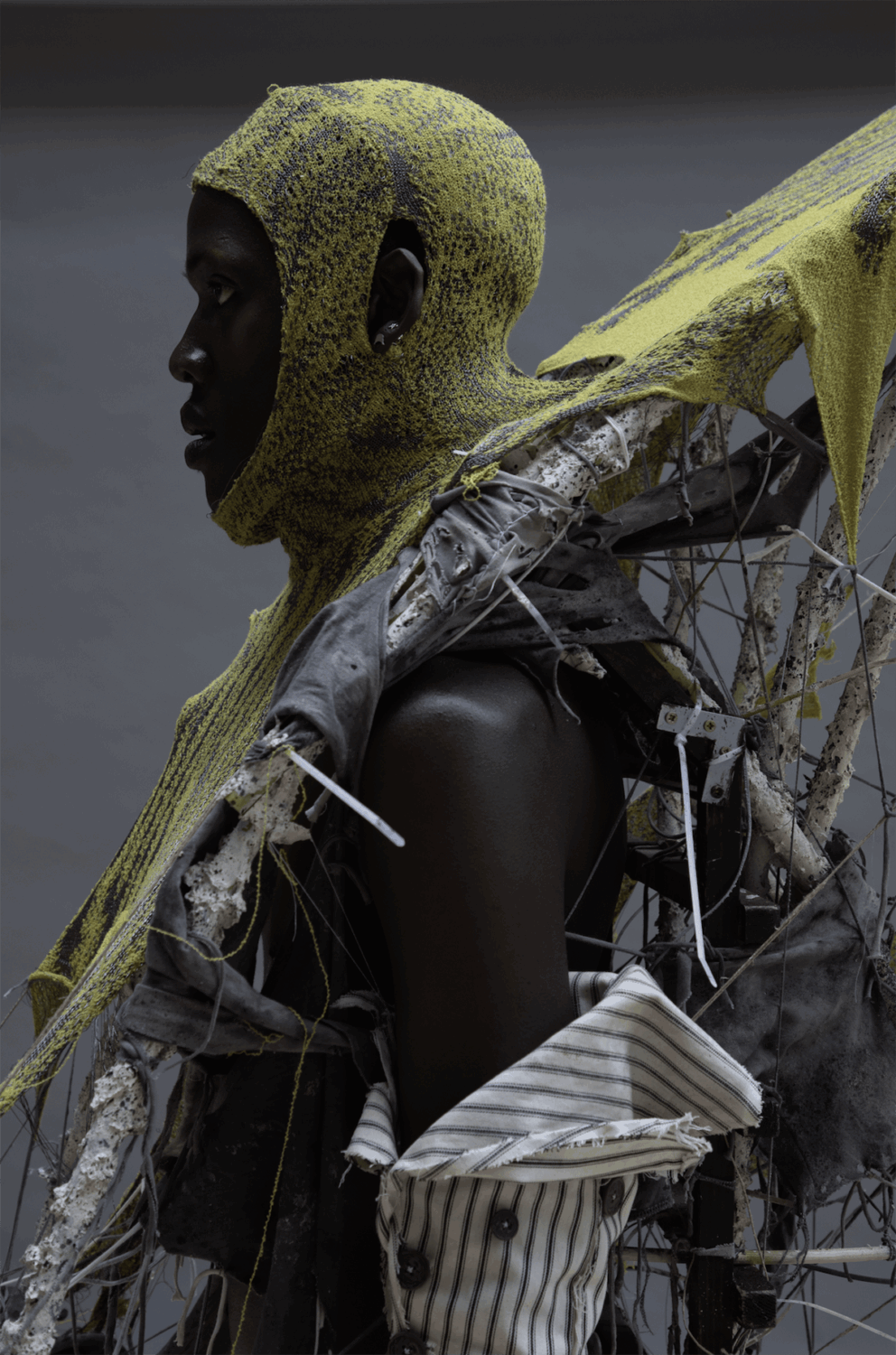
Yodea Marquel Williams 2024
An affirmation from the catalogue reminds us: “If we are to move forward, fashion’s dirty side first needs to be explored and reckoned with.” We asked the curator about how fashion exhibitions can be a vehicle to think about intersectional matters and reach beyond the interest of fashion people: “There are enough places doing fashion exhibitions, and we are in a place that is very multidisciplinary and intersectional. It’s very alive. So we want to show fashion as an embodied and living practice. For the Barbican, fashion can be shown as something that is part of culture, the cultural fabric, that touches all the different arts. It’s not just fashion as art, or trying to make it a high-art show. It talks to different people also, not just to fashion enthusiasts. Fashion is a very accessible medium to talk about these issues.”
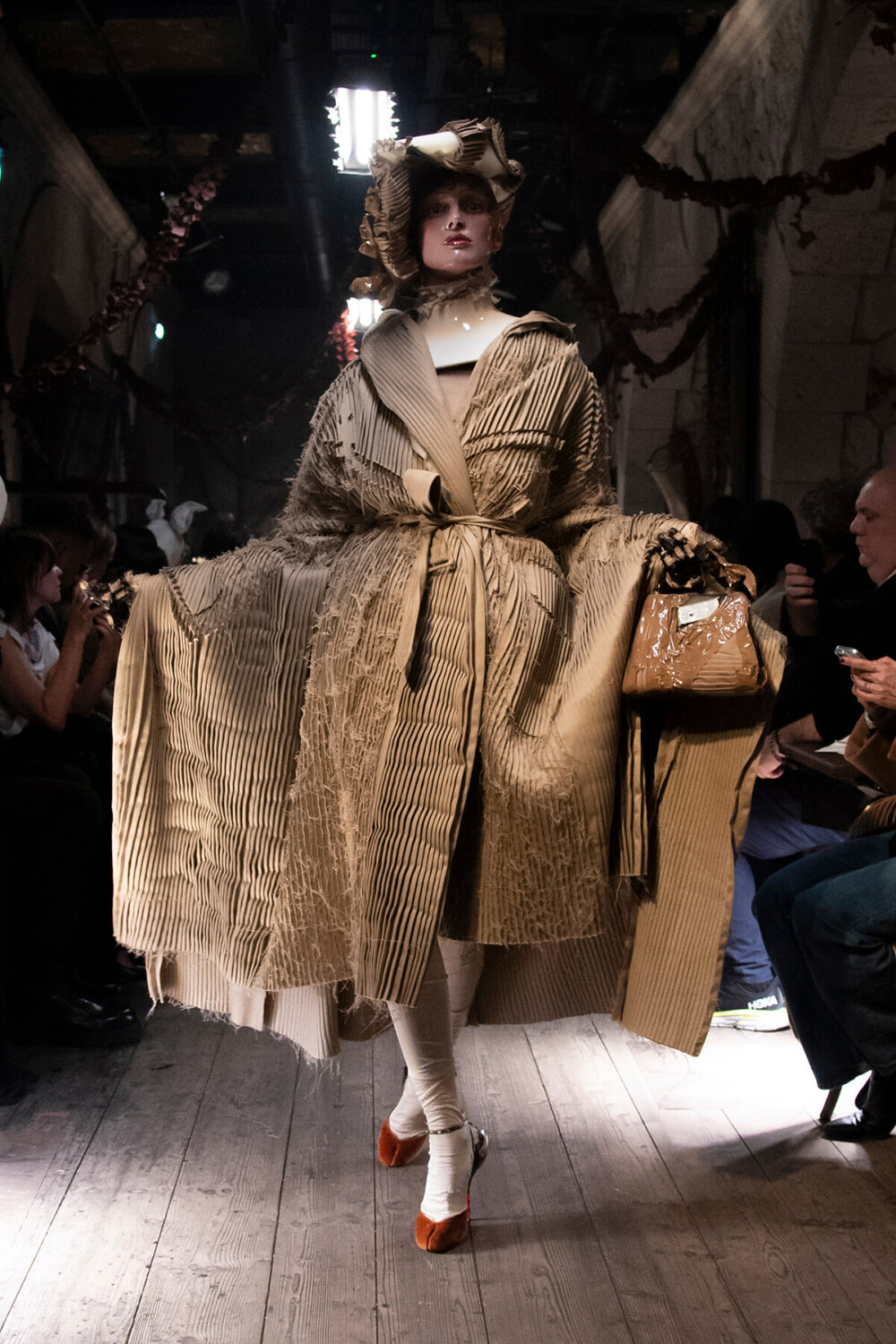
Maison Margiela Spring/Summer 2024
DIRTY LOOKS invites us to understand dirt as a social construct, while exposing issues the fashion industry must confront, but also suggests fashion exhibitions can reach beyond the fashion sphere, as intersectional spaces for dialogue.
–
Follow us on TikTok @veinmagazine


